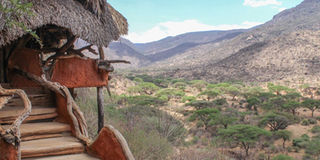A stunning community-owned lodge

A view of the expansive ranch from the reed-thatched rooms. PHOTO I JAN FOX
What you need to know:
- Bordering Lewa Wildlife Conservancy, their land is a vital corridor for wildlife moving between Samburu, Laikipia and Mt Kenya. Over time, wildlife numbers started bouncing back.
- Yes, some of the lodge needs a little work, minor infrastructural things mainly, but I got a sense that the excellent staff are really pushing to regain its reputation, and that it won’t take a lot to make this place outstanding.
- To explore the conservancy, the lodge includes a daily game drive, walk and community visit. We took a number of walks and were lucky to see Reticulated giraffe, gerenuk, Günther’s dik dik, and even some spotted hyena on the prowl.
Our conservation landscape has undergone somewhat of a revolution in the last decade or so. The most significant aspect has been the establishment of formal community initiatives to conserve their land and wildlife.
In many instances, funding for these conservancies has relied on donations and grants. Eco-tourism is also a vital contributor. In most cases, private investors lease community land to put up camps and lodges, paying bed-night and conservation fees. Sometimes, communities own these lodges but third parties manage them. There is one exception, however.
Il Ngwesi is arguably the only upmarket lodge in Kenya that is totally owned, managed and staffed by a community. They are celebrating their 20th anniversary this year and I had a chance to visit. I had heard through the grapevine that the lodge was struggling in the recent tourism downturn and that some of the infrastructure was getting tired. I was curious to see for myself.
The lodge is named after the local Maasai. “Il Ngwesi” translates as “People of Wildlife”. They are part of the Il Laikipiak clan and have lived in this area for generations. In a pioneering move, they set aside a large proportion of their group ranch to support sustainable wildlife conservation and rangeland regeneration.
Bordering Lewa Wildlife Conservancy, their land is a vital corridor for wildlife moving between Samburu, Laikipia and Mt Kenya. Over time, wildlife numbers started bouncing back. The lodge was built through the help of Lewa, USAid and donors to allow the community reap from their property.
HUGE ADVANTAGE
Over the years, the lodge has won numerous awards, mainly as a result of their significant socially responsible principles. It has also been lauded for its architecture. There are six airy rooms, all built on platforms under reed-thatch roofs. They come with outdoor showers and two of them have a double bed on wheels that can be moved outside for the ultimate romantic experience – a star bed. There’s also a lounge and a swimming pool.
The views are simply spectacular. Some of the rooms, and the main lounge, look northwards towards the Mathews Range and Samburu. Others look down into a valley between the Mararoi Hills, at the bottom of which there is a waterhole and a seasonal stream.
It’s currently very dry, and the sheer diversity of animal life that visited the pipe-fed waterhole was breathtaking. Hundreds of doves, guineafowl and quelea flocked for a drink, only to be ambushed by a pair of African Hawk-Eagles. A lone bull elephant arrived at one point to disrupt the queued-up impala, baboons, bushbuck, zebra (both Common and Grevy’s), jackal, waterbuck, warthog and Lesser kudu. There’s a shaded hide above the waterhole, for those that can’t see it from their rooms.
Yes, some of the lodge needs a little work, minor infrastructural things mainly, but I got a sense that the excellent staff are really pushing to regain its reputation, and that it won’t take a lot to make this place outstanding. They have a new website (www.ilngwesi.com) and marketing strategy, and the manager, James Kasoo, struck me as a dedicated and determined individual.
To explore the conservancy, the lodge includes a daily game drive, walk and community visit. We took a number of walks and were lucky to see Reticulated giraffe, gerenuk, Günther’s dik dik, and even some spotted hyena on the prowl. There is also a fenced rhino sanctuary with two very relaxed White rhinos that were translocated from Lewa.
A huge advantage to Il Ngwesi is the genuine community immersion. Your hosts and guides are locals, and the six Maasai villages are all welcoming. Some local women are also contributors to the NRT’s BeadWORKS project that supports their creative talents.
Full board rates for residents is Sh17,000 which includes all meals, soft drinks, tea, coffee and the daily activities mentioned. Conservation fees are Sh750. Transfers, alcohol, rhino walks and beauty treatments are all available as extras.
Non-resident rates are $300 and $45 for conservation fees. Il Ngwesi also offers fully catered camping safaris at Sh8,500 and $100 respectively. Stays longer than two nights include a game drive on Lewa too. There are numerous special offers, child rates and also self-catering packages for groups of up to 20 people, all which can be requested from [email protected] or by calling +254(0) 714 956049.
It is possible to drive all the way to the lodge via Lewa or Isiolo, but you need a car with good ground clearance, preferably 4x4. Alternatively, transfers can be arranged from Isiolo, Lewa or Timau.





